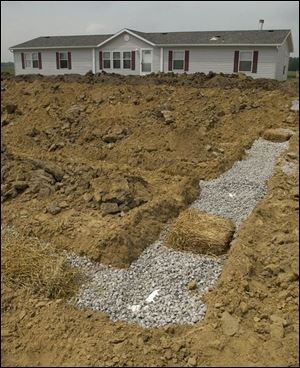
Country version of the sewer
6/15/2003
Tons of sand and stone are required for the leach field.
Getting the septic tank pumped every three to 10 years is a household chore that makes its way onto long-range to-do lists of only the most fastidious rural homeowners.
“I know there's a lot of tanks that aren't cleaned for years. You'd be lucky if 20 percent get cleaned every five to eight years,” said Russell Steffel, who operates a Defiance County septic tank installation service under his own name.
“Nobody wants to mess with it. It's an extra expense that people don't really think they need. But it prolongs the life of the system.”
Septic tanks are the most typical rural substitute for a municipal sewer system. The number of septic tanks in the area probably peaked 10 to 20 years ago; since then, development has lagged the pace of extension of municipal sewer lines. Still, a few septic systems are in Lucas County, and some are even in Toledo.
The tanks, which are often made of concrete, collect waste that flows from toilets, bathtubs, sinks, washing machines, and other drains in the buildings. Health departments typically recommend a 1,000-gallon tank for a one-bedroom home and a 2,500-gallon tank for six or more bedrooms. Drain or leach fields, which are part of the septic system, usually are 2,000 to 7,000 square feet.
Costs for installing such a system, which is underground, typically range from $4,000 to $15,000. Installation includes soil tests; some soil is better able to absorb and transport liquids.
Ideally, solid wastes settle to the bottom of the tank and wastewater filters into the underground drainage area. The solid material is what builds up in the tank and should be removed.
For large families, Mr. Steffel suggests pumping the tank every three years. People who live alone and don't have a garbage disposal or use much water often can get by with pumping the septic tank every decade. Pumping typically costs $100 to $200.
If a septic tank is not pumped regularly, accumulated solids can clog the leach field. That can lead to a backup in drains or to sewage rising to the soil surface outside. If that happens, there are few simple fixes. Contractors often recommend starting over with a new tank and leach field.
Septic tank systems, experts say, typically last 20 to 25 years. Septic fields generally are near the house. Maps and other paperwork describing the systems often are on file with the county health department.
The home's water well should be at least 50 feet from the septic system, and driveways, buildings, or trees should not be placed above it.
Requirements vary by county, but often numerous semi trailer loads of sand and stone are needed for the leach field. For most systems, the property must be at least a half-acre. Smaller lots sometimes have a system with an aerator, powered by electricity.
In Lucas County, newer systems were inspected by the county health department when they were built. The county requires permits for work done on septic systems. But for $50 the agency will do an inspection at any time and provide a letter of findings.
Inspection costs in other counties vary by county.
Experts recommend that property owners with septic tanks not pour much bleach and other harsh cleaning solutions down the drain because large amounts of such chemicals can upset the bacteriological digestion in septic tanks.
If municipal sewer lines are extended past a property, Ohio law requires property owners to hook on.
The cost of such public sewer lines is typically assessed to the property owner.